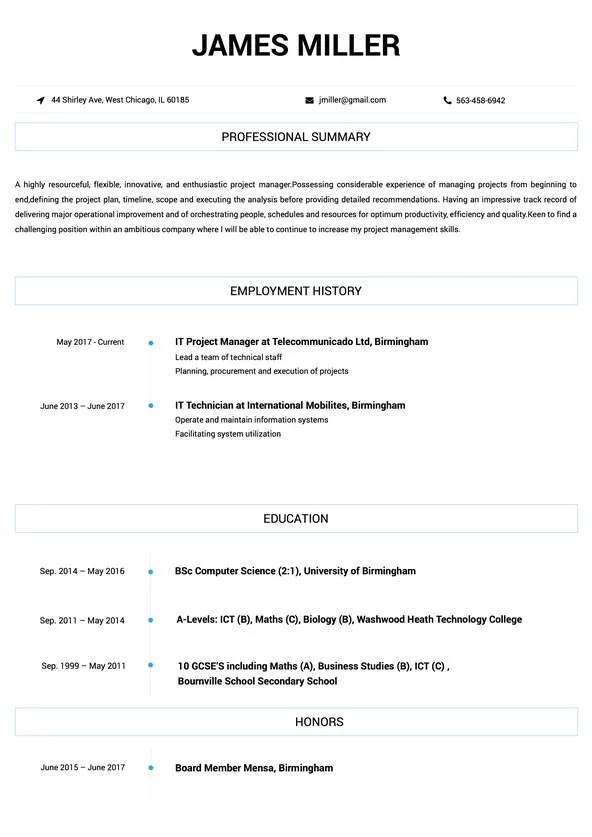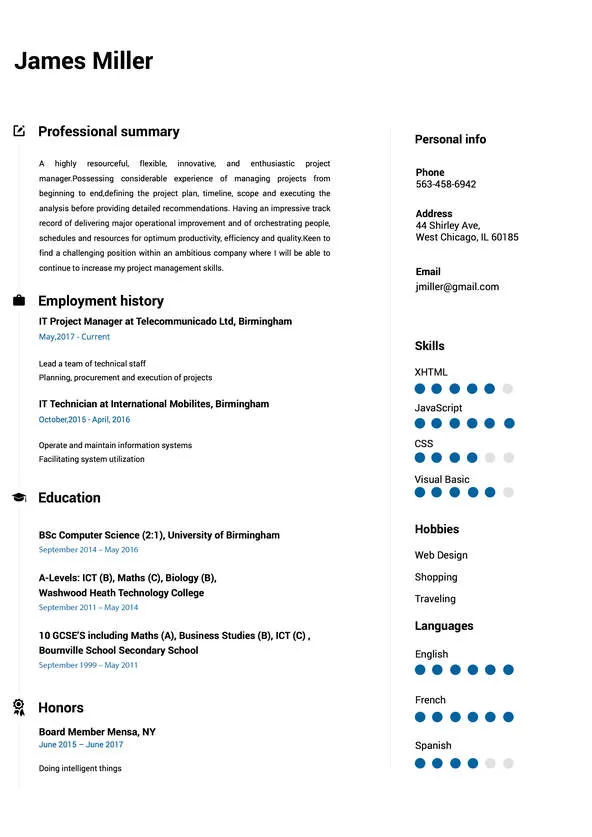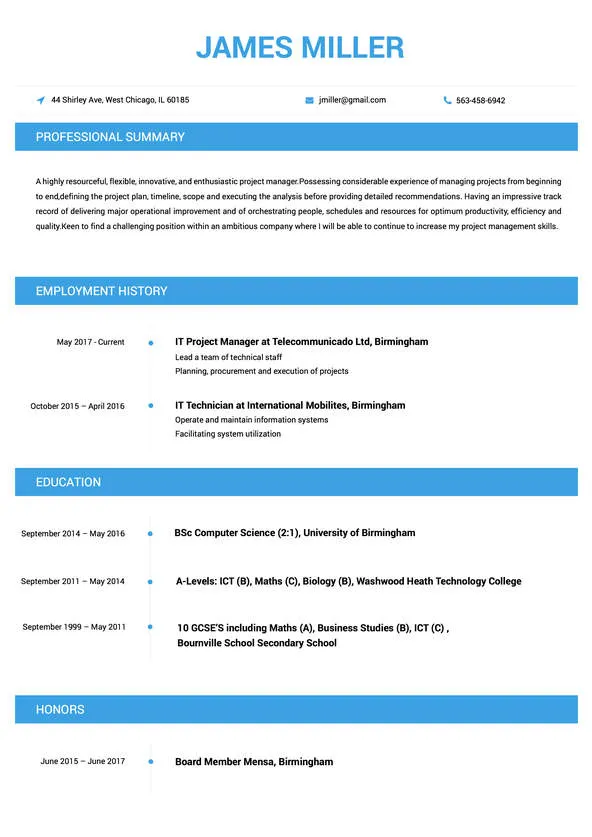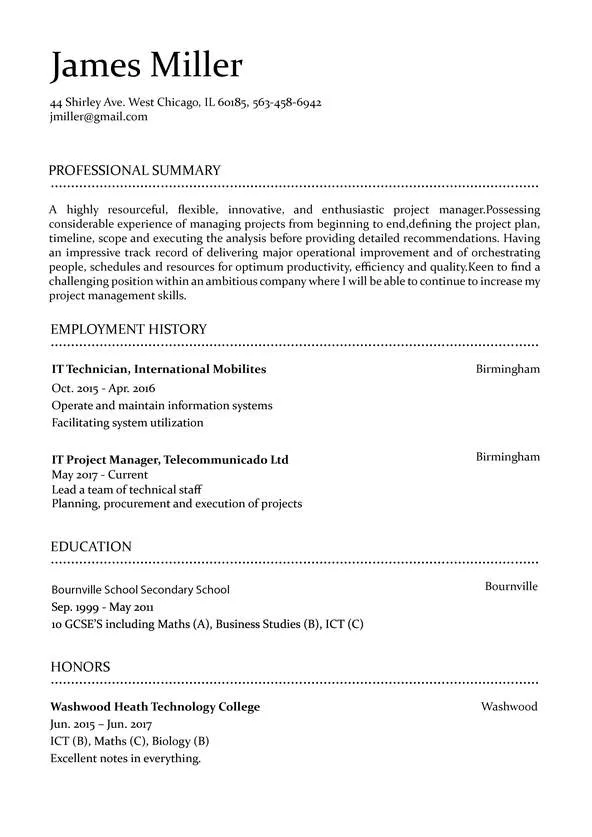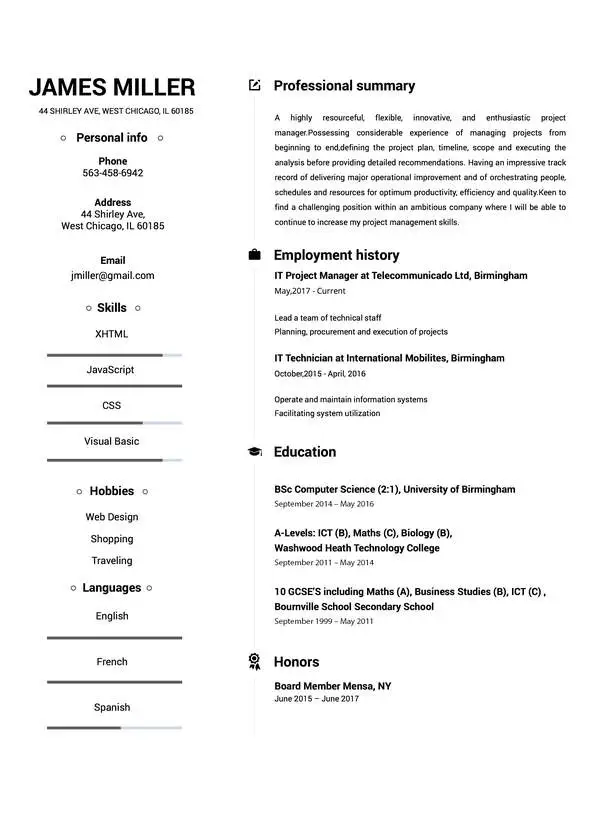 Use This Template
Use This Template
Build your resume in 15 minutes
Create an awesome resume that meets the expectations of potential employers with our selection of professional, field-tested resume templates.
caregiver: Resume Samples & Writing Guide
Employment history
- Ensure compliance with applicable laws, regulations, and standards
- Maintain a safe and therapeutic environment
- Instruct clients on proper use of adaptive and assistive devices
- Monitor client's progress and document changes
- Provide transportation and accompany clients to appointments
- Assist clients in performing therapeutic activities
- Provide transportation and accompany clients to appointments
- Administer medications and treatments as prescribed
- Assist clients in performing therapeutic activities
Education
Skills
Do you already have a resume? Use our PDF converter and edit your resume.
Employment history
- Participate in interdisciplinary team meetings
- Assist with activities of daily living (ADLs)
- Assist clients in developing, implementing, and maintaining daily living skills
Education
Skills
Employment history
- Communicate effectively with clients, families, and other healthcare providers
- Promote client independence and self-care
- Provide transportation and accompany clients to appointments
- Administer medications and treatments as prescribed
- Assist with activities of daily living (ADLs)
- Assist clients in developing, implementing, and maintaining daily living skills
- Instruct clients on proper use of adaptive and assistive devices
- Provide education and support to families
- Ensure compliance with applicable laws, regulations, and standards
Education
Skills
Professional Summary
Employment history
- Maintain a safe and therapeutic environment
- Assist clients in performing therapeutic activities
- Provide emotional support and encouragement to clients
- Provide education and support to families
- Provide transportation and accompany clients to appointments
- Assist with activities of daily living (ADLs)
- Maintain a safe and therapeutic environment
- Ensure compliance with applicable laws, regulations, and standards
- Provide emotional support and encouragement to clients
Education
Skills
Professional Summary
Employment history
- Assist clients in performing therapeutic activities
- Assist with activities of daily living (ADLs)
- Develop and implement individualized care plans
- Assist clients in developing, implementing, and maintaining daily living skills
- Assist clients in performing therapeutic activities
- Ensure compliance with applicable laws, regulations, and standards
- Monitor client's progress and document changes
- Assist with activities of daily living (ADLs)
- Ensure compliance with applicable laws, regulations, and standards
Education
Skills
Not in love with this template? Browse our full library of resume templates
Increasing automation has made the job market look bleak for many professions. However, not every job is impacted by this phenomenon. Caregiving is a prime example of an occupation that is set to offer job security for years to come. After all, there isn’t a machine replacement for the human to human care and contact that caregivers offer their patients.
There’s also another significant factor that makes caregiving one of the most secure professions. The population is ageing at an unprecedented rate. The United States Census Bureau projects that the 2030s will be a transformative decade in part because the population is expected to grow at a slower pace and age considerably.
In fact, within a few decades, the Bureau projects that older people will outnumber children for the first time in U.S. history. “By 2034 (previously 2035), there will be 77.0 million (previously 78.0) people 65 years and older compared to 76.5 million (previously 76.7 million) under the age of 18," says Jonathan Vespa, a demographer at the Bureau.
By implication, the need for caregivers is likely to exponentially increase in order to keep up with the growing demand for caregiving services. This is reflected by data from the US Bureau of Labor Statics that projects a 36 percent growth of overall employment of home health aides and personal care aides from 2018 to 2028. Given that the average projected employment for all occupations during that same period is only 5 percent, this signifies eye-wateringly high expected job growth in the caregiving sector.
So does that mean that you no longer need to bother fixing up your resume in order to apply for caregiver jobs? Definitely not!
Keep in mind that just because there are more jobs, that doesn’t mean they’ll all be worth applying for. And it certainly doesn’t mean you’re a shoo-in for a great position if you don’t make any effort with your resume. If you want to be hired for a caregiving job that comes with solid pay and benefits, you will need to create a winning caregiver resume.
Our resume guide below will run through all of the essential information and tips you need to make an incredible caregiver resume. You should read it if you want to learn crucial matters including:
- Which sections to include in your resume
- How to correctly list your education, training, and certifications
- Expert tips for selecting the right achievements and skills
- What you should do if you’re an entry-level caregiver
- How to easily and quickly make a stunning resume
1. Multiple Template Examples
2. How to Write a Caregiver Resume That Will Get You Noticed
How to format your caregiver resume
We strongly advise that caregivers who wish to put their best foot forward should use a reverse-chronological format for their resume. This format is designed to enunciate your professional progression. It does this by ordering your work history from your most to least recent job.
Another recommendation we believe that all caregivers will benefit from is following some tried-and-true resume layout guidelines, which we’ve noted below. These guidelines were created to make it easier for candidates’ resumes to align with recruiters’ expectations of them.
- Number of Pages: All resume content must fit within a single page.
- Fonts to Use: Standard fonts that won’t rock the boat. For example, Cambria and Helvetica.
- Fonts to Avoid: Any font that you wouldn’t use to update your patient’s files with. For example, FF Trixie and Jacques & Gilles.
- Margins: 1 inch on all sides.
- Line Spacing: 1 or 1.15.
- Header size: 14-16 point size.
- Text size: 11-12 point size
What should a caregiver put on a resume?
Every strong caregiver resume will invariably feature a number of standard sections. These sections are required due to the practical information they provide about your professional experience, skills, and training. They also offer you the opportunity to put a spotlight on the attributes you have as a caregiver that distinguish you from other candidates. Here are the most critical sections to include in a caregiver resume:
- Contact information: Information that allows a recruiter to easily contact you or look further into your professional background. Include your name, home address, phone number, email address, and LinkedIn profile URL.
- Resume objective or resume summary: A short statement that aims to frame you as an ideal candidate. Include one or the other, based on your level of professional experience.
- Education: Significant details about your educational background.
- Training and certifications: Details about any additional training and certifications you have undertaken that are relevant to the position at hand.
- Professional experience: An overview of each relevant position you’ve held that features your most attractive and relevant achievements.
- Skills: A list of 6 to 8 of the most relevant skills you possess that will help you succeed in the position.
How to list your educational background in your caregiver’s resume
Many caregivers assume that after all of their years of professional experience, they no longer need to list their educational background on their resume.
The thing is, recruiters will only consider applications from caregivers who at least meet the minimum educational requirements to work in the given position. It’s worth keeping in mind that recruiters won’t waste their time trying to figure out if you meet them. So make your educational background as clear as day on your resume.
In order to correctly list details about your education background, make sure to provide the following information. The order in which you do so will depend on the resume template or overall format you use:
- The name of the degree
- The name of the college or institution
- The state it is located in
- The year you graduated or the years you have studied
For example:
- Certified Nurse Aide Course, Austin Community College, TX, 2019 - Present
- High School Diploma, Bellville High School, 2014 - 2018
Pro Tip: Instead of separating your “Education” and “Training and Certifications” sections, you’re welcome to create a singular section that combines the two called “Education, Training, and Certifications”.
How to list additional training and certifications as a caregiver
If you have any additional training and certifications as a caregiver, listing them on your resume is critical for three main reasons.
Firstly, there may be specific licencing, training, or other certifications that are mandatory in your particular state. Moreover, there may be particular certifications the Professional Association of Caregivers recommends caregivers in your state to hold.
If you’re wondering what they are for your state, Caregiverlist provides a clear state-by-state outline of them. For example, the resource states that in Arizona, licensure for home care agencies requires basic caregiver training and direct care worker caregivers (DWC) for Medicaid (ALTECS) must have 6 hours of training. In terms of non-medical training, it states that the Professional Association of Caregivers recommends Arizona caregivers to undertake a 8 hour certification course.
Secondly, there may be mandatory training and certifications requirements for the specific type of caregiving work you currently do or want to do. For example, in order to work as a respite care provider, you must undertake additional training. While some workplaces offer in-house training, it’s usually preferable to have the appropriate training needed to work in a given role.
Last but not least, listing additional training and certifications, such as CPR and first aid training, will make you a more attractive candidate in the recruiter’s eyes. Why? Further training exemplifies both your passion for your professional development and your desire to provide your patients with the best quality care possible. So if it boils down to two comparable candidates, a recruiter will, no doubt, give strong preference to one who has more relevant training.
So how should you list your additional training and certifications on your resume?
We advise that you provide the following information about each one:
- The name of the training or certification
- The name of the organization that issued it
- The state where you undertook it (as appropriate)
- The year you received the training or certification
Below are some examples of this format in practice:
- National Caregiver Certification Course (NCCC), American Caregiver Association, 2017
- Certified Nursing Assistant, Advanced Medical School of Nursing, CA, 2018
- First Aid Training, Red Cross, 2020
- CPR Training, Red Cross, 2020
Be sure to order your certifications and training from most to least relevant in regards to the given position!
Pro Tip: It’s always a good idea to update your resume with new certifications and training if you want to retain your competitiveness as a candidate. If you’re after some ideas, check out this list of 50 courses and training for caregivers.
How to highlight your most important achievements
If you want to highlight your most important achievements in a way that immediately commands a recruiter’s attention, you’ll need to use the following method:
Before you start working on your “Professional Experiences” section, you will first need to select the most appropriate achievements to include. A simple rule of thumb to remember is to choose those that are directly relevant to the job application.
So how do you pinpoint which of your achievements are actually relevant? Just take a careful look at the job ad of the position you wish to apply for. Keep your eyes peeled for words that describe the qualities a recruiter is looking for from their ideal caregiver. These words are referred to in the human resources industry as ‘keywords’.
Keywords are used by recruiters to make it clear what attributes candidates like yourself need to offer in order to get a look in. These attributes may include both mandatory requirements a caregiver must have as well as ‘nice to haves’.
In order to inform the recruiter which of these attributes you personally possess, you need to incorporate the keywords that apply to your professional experiences into your achievements.
To make this all clearer, let’s use a hypothetical scenario to run through the entire process of identifying keywords and creating an achievement around them.
First of all, you’ll need to pretend that you want to apply for a position with the following job requirement:
- Experience with housekeeping, meal preparation, and other caregiving tasks
In order to target this requirement in your achievement, you’ll need to first identify the keywords in it. Have a go for yourself.
You should have successfully identified 3 keywords:
- Housekeeping
- Meal preparation
- Caregiving tasks
Next, you’ll need to work out if your experiences match up with these keywords. For the sake of this scenario, let’s assume they all do. You’ll then need to select a relevant work achievement that exemplifies your understanding of the duties and skills that these keywords represent.
Finally, you’ll need to write out this achievement, making sure to do so in an engaging way that includes the chosen keywords.
To show you how to do this properly, let’s compare how a good vs bad caregiving resume achievement with these keywords looks like:
- Performed quality housekeeping, meal preparation, and other caregiving tasks using my skills in housekeeping, meal preparation, and other caregiving tasks to get the job done.
Have you picked up on why this achievement sounds so off? The candidate has unnaturally added the keywords into their achievement, which is a practice known as ‘keyword stuffing’. Keyword stuffing is heavily frowned upon for two main reasons.
Firstly, it represents a clear attempt by a candidate to manipulate the Applicant Tracking System (ATS). ATS is a type of recruitment software that evaluates whether a resume meets a recruiter’s criteria, based on the keywords it does or doesn’t include.
Keyword stuffing is also frowned upon, because it makes your writing sound stiff and disjointed. Needless to say, writing like this is an easy way to cause a recruiter to instantly lose interest in your application.
So what should you do instead? Take a look for yourself:
- Performed all caregiving tasks, including housekeeping and meal preparation, in line with my knowledge of each patient’s needs to ensure they all received personalized care.
Just like the example above, your sentences should flow well. You can achieve this feat by incorporating keywords into each achievement in a natural way. If any of them are difficult to read or sound robotic, it’s time to rewrite them.
Another thing you should follow suit on is ensuring that your achievements emphasize why they’re noteworthy. Unlike the previous candidate, this candidate didn’t just plainly state that they can perform the caregiving tasks the recruiter is looking for. They additionally explained how they performed the tasks and the result doing so had. That is, this candidate applied their “knowledge of each patient’s needs” so that the patient’s could “receive personalized care.”
So if you want to write an equally impactful achievement, remember to explain both what you did and the positive result it brought about.
Which hard and soft skills should be mentioned on a resume?
If you’re finding it tough to determine which skills to include in your resume, the good news is that it’s more black and white than you think.
In fact, if you read the section above, you already know how to select the right ones. Yes – it all comes down to keywords!
You can use the method we described above to pinpoint which skills-focused keywords the recruiter is after. To recap, all you need to do is scan the job ad for keywords that represent what the recruiter is looking for. In this case, you should hone in on finding skills-focused keywords.
You’ll then need to select which ones are most relevant to your own skill set. A recruiter may ask you to elaborate on your skills, so honesty is always the best policy.
Where should you mention them, then? You should list the best 6 to 8 of your skills in your resume’s “Skills” section. Additionally, you should add them naturally throughout your work experience achievements. One final section you should include 1 or 2 of them in is your resume objective or summary.
It’s vital to search for both hard and soft skills when looking at a job ad. Hard skills are measurable technical skills that are usually related to a specific profession. Soft skills are intangible interpersonal skills that are usually shared across a range of professions.
Here are some examples of common hard and soft skills for caregivers that we extracted straight from real-life job ads:
Hard skills
- Setting up, serving, and cleaning up after the meals
- Providing laundry service
- Following incident reporting guidelines
- Organizing individual resident and group activities
- Facilitating move-in and move-out processes
- Assisting residents with their daily routines
- Transporting residents
- Assisting patients in and out of bed
- Proper wheelchair transfer
- Maintaining a healthy environment
Soft skills
- Compassionate
- Patient
- Dedicated
- Reliable
- Prompt
- Friendly
- Resourceful
- Positive attitude
- Honesty
- Written and verbal communication skills
What are the differences between resume objective and summary? When should I use each one?
A resume objective or resume summary both allow you to define yourself as a strong candidate to a recruiter as soon as they start reading your resume. These sections share a number of features in common. For example, they should both be positioned directly below your contact information. This means that one or the other will represent the first major section of your resume. Another key similarity is that they should both be around 2 to 4 sentences long.
However, while they are similar, you should not mistake them for being the same. In fact, you should only use one of them on your resume. It’s easy to work out which one is suitable for your situation. It all depends on your level of experience. That is:
- If you’re an entry level candidate with little to no experience, use a resume objective.
- If you’re an experienced caregiver, use a resume summary.
It is vital that you don’t use the wrong one as the purpose and focus of each is distinct.
The purpose of a resume objective is to convince a recruiter that you are a worthy candidate even in spite of your minimal or non-existent professional experience. You can do this by focusing on all of the other relevant attributes that you can bring to the table.
Compare this to the unique focus and summary of a resume summary. The purpose of a resume summary is to explain why you’re the most ideal candidate, compared to all other candidates. You can do this by focusing on the ideal blend of relevant professional competencies you offer as an experienced caregiver.
Once you’ve worked out which is best for your situation, read our pointers below for writing either an amazing resume objective or summary.
How to write a resume objective? (Examples included)
To accomplish writing an incredible resume objective, you need to know what to avoid and what to aim for.
A common mistake entry-level candidates make is that they project their lack of confidence onto their resume objective. An equally common mistake is that they don’t give a recruiter a convincing reason to hire them. Here’s a resume objective example that shows these mistakes clearly:
- Aspiring caregiver who lacks any professional experience is after an entry-level role. I think I’ll make a great caregiver but as I haven’t developed any of the necessary skills yet I’m looking for an employer who will teach them to me.
So what should you do instead? Make sure you don’t undersell yourself. You might not feel confident about your worthiness as a candidate, but try to put that aside for a minute. If you want to score your dream job, your resume objective needs put a spotlight on your very best and most relevant attributes.
To do this, concentrate on branding yourself as a highly-competent aspiring caregiver. To show you have a bright future ahead, make sure to mention any relevant skills, training, education, internships, and professional experiences you have. The following example shows all of these features in action:
- Aspiring caregiver with first aid and CPR training is eager to put their passion for caregiving into practice in an entry-level role at Sunny Caregivers. Thanks to my internship at Hillside Caregivers, I have developed a range of skills, such as assisting patients in and out of bed and proper wheelchair transfer, that I can utilize in this role.
How to write a resume summary? (Examples included)
Think of your resume summary as your elevator pitch to a recruiter. Imagine if you had the opportunity to read it out loud to them - how do you think they’ll react?
If your resume summary sounds uninspiring and is irrelevant to what the recruiter is looking for, you’ll be sabotaging your chances. Many experienced candidates think that the ‘main’ part of their resume will do the talking for them, so they just write a vague and bland resume summary like this candidate did:
- Caregiver with 5+ years of experience who loves their job. Looking for a new role at Paradise Caregivers so I can keep developing my useful caregiving skills.
If your own one looks anything like that, don’t expect to make it to the interview stage. Your resume summary should convince a recruiter that the rest of your resume is worth reading. It should make it clear that out of all of the competent caregivers out there, you bring something extra special to the table.
You can do this by hand-picking the most relevant and impressive attributes you offer that a recruiter would be intrigued by. Ultimately, you need to make it clear why it would be in the recruiter’s interests to hire you – and not the other way around like the previous candidate did.
Be sure to include a summary of your most eye-catching qualifications, skills, training and certifications, as well as professional experiences. For bonus points, try to quantify your achievements (you can read more about this further below). The following example exhibits all of these recommended qualities a resume summary should have:
- Caregiver with 5+ years of experience who has won “Employee of the Month” twice due to the unwavering dedication and positive attitude I demonstrate when assisting residents with their daily routines. Looking to work at Paradise Caregivers so that I can utilize the patient-focused approach I take – one that has led to a 25% increase in patient referrals – at a larger caregiving organization.
How to write a caregiver resume with little to no experience
The most important thing to keep in mind if you have little to no caregiving experience is to make the recruiter aware of the unique qualities, skills, and knowledge you offer. Don’t underestimate the impact this will have! It’s common for entry-level candidates to overemphasize what they lack, so taking this more positive approach will be sure to leave a great impression.
For example, while you may not have any caregiver certifications to your name, you can instead emphasize your training in other relevant areas such as first aid, CPR, or anaphylaxis.
Likewise, in the place of caregiver-specific work experience, you’re welcome to highlight any relevant work experiences, volunteer experiences, and internships. Just make sure to make them as relevant as possible to caregiving. For example, if you worked at Target, you can feature your customer service skills and communication skills as these are also skills used in caregiving.
At the end of the day, recruiters for entry-level roles are looking for someone who is responsible, proactive, and passionate about their future in caregiving. If you can show these things in your resume, and also put a spotlight on your most relevant attributes, you’re sure to score your very first caregiver job in no time.
How to make your resume stand out
An effective way to distinguish your resume from the pack is to make a concerted effort to make your resume stand out. Here are our top 3 tips for doing so:
- Quantify your achievements: We’ve already explained the importance of highlighting the positive outcome your achievements have had. But to really impress, quantify this impact whenever possible by using relevant numbers and percentages. For example, to quantify “Received positive feedback from patients” you could add, “...leading to a 98% satisfaction rating in the annual patient survey.”
- Cut the fat: While you’ll need to include detailed information in a patient’s case report, you shouldn’t take this same approach with your resume. Each section should directly address what the recruiter is looking for. Anything else may need to be cut out if your resume is starting to look too full. White space can go a long way in making your resume look more presentable.
- Read your resume out loud: You should only submit your resume once you’re certain that it’s 100% mistake free. Even after using a spell checker and proofreading it, mistakes can still slip by. That’s why we recommend reading your whole resume out loud. While your eyes may have glazed over reading it countless times, this method provides a new opportunity to catch any sneaky errors.
3. How Resumebuild.com’s Resume Builder Tool Helps You Create a Resume That Impresses Recruiters
If you can effectively do absolutely all of the things we mentioned above, then you’re set to make an unforgettable impression on a recruiter. If you’re able to apply a few of the pointers we shared, you’ll at least be able to make some leaps and bounds with your resume. However, it will still fall short of completely wowing a recruiter.
Your job is stressful enough without needing to add the stress of putting together a perfect resume. That’s why it’s a wise decision to utilize a reliable resume builder to get the job done.
If you’re feeling a bit guilty about doing so, just remember that recruiters use ATS software to help themselves out. Similarly, you can use a resume builder to help yourself out. It’s also worth keeping in mind that a high-quality resume builder like Resumebuild.com’s offering won’t just spit out a generic resume for you. In fact, any resume builder that does this has red flags all over it!
Our resume builder is designed to do most of the heavy lifting for you – it even provides pre-written examples just for caregivers! That being said, you’ll still need to provide information about yourself in order to make your resume unique to you. The reason we don’t offer a ‘one size fits all’ approach is because we recognize that customizing your resume to each specific application is a surefire way to get noticed by recruiters.
So if you’re ready to use a resume builder that has your best interests in mind, rest assured that our professional and efficient resume maker is it.
caregiver Job Descriptions; Explained
If you're applying for an caregiver position, it's important to tailor your resume to the specific job requirements in order to differentiate yourself from other candidates. Including accurate and relevant information that directly aligns with the job description can greatly increase your chances of securing an interview with potential employers.
When crafting your resume, be sure to use action verbs and a clear, concise format to highlight your relevant skills and experience. Remember, the job description is your first opportunity to make an impression on recruiters, so pay close attention to the details and make sure you're presenting yourself in the best possible light.
caregiver
- Check vitals ,weight and blood sugars
- Bathe patient
- Dress patient
- Responsibilities include assisting residents with bathing, dressing, grooming, toileting, transferring, and any other required assistance with activities.
caregiver
- Organized, prepared, and monitored medications and meals
- Assist patients with basic neccessities
- Constant companionship and supportive listening
- Daily communication and updates with guardians about patient’s progression/complications
caregiver
- Monitor all aspects of resident
- Assess the needs of individuals and families to identify potential health or safety problems in care, including diet and physical activity.
- Prepare and serve meals to residents or other family members, according to prescribed diets.
- Administer prescribed medications or start intravenous fluids, noting times and amounts on residents’ charts.
caregiver/ van driver
- Established and maintained a safe environment for the children.
- Safely transport children to and from school and extra-curricular activities.
- Assist in personal hygiene and dressing
- Assist with cleaning and laundry task
caregiver
- Responsible for getting kids to and from school on time.
- Help to prepare and serve nutritious snacks for the children.
- Communicate with parents about daily activities, behaviors and related issues.
- Instruct children in safe behavior such as paying attention to their surroundings and avoiding dangerous situations.
- Organize age related activities, games, arts and crafts, sports.
- Transport children to and from doctor, dentist appointments, girl scouts, dance, birthday parties,field trips sports, social outings.
- Supervise and assist with homework and school projects.
caregiver Job Skills
For an caregiver position, your job skills are a key factor in demonstrating your value to the company and showing recruiters that you're the ight fit for the role. It's important to be specific when highlighting your skills and ensure that they are directly aligned with the job requirements, as this can greatly improve your chances of being hired. By showcasing your relevant skills and experience, you can make a compelling case for why you're the best candidate for the job.
How to include technical skills in your resume:
Technical skills are a set of specialized abilities and knowledge required to perform a particular job
effectively. Some examples of technical skills are data analysis, project management, software proficiency,
and programming languages, to name a few.
Add the technical skills that will get hired in your career
field with our simple-to-use resume builder. Select your desired resume template, once you reach the skills
section of the builder, manually write in the skill or simply click on "Add more skills". This will
automatically generate the best skills for your career field, choose your skill level, and hit "Save &
Next."
- Telehealth
- Patient Care
- Medical Terminology
- Patient Education
- Medical Records
- Documentation
- Home Care
- Physical Therapy
- Nursing
- Rehabilitation
- Clinical Skills
- Charting
- Wound Care
- Vital Signs
- Mobility Assistance
- IV Therapy
- Infection Control
- Pain Management
- Cognitive Therapy
- Interventions
- Assessments
How to include soft skills in your resume:
Soft skills are non-technical skills that relate to how you work and that can be used in any job. Including
soft skills such as time management, creative thinking, teamwork, and conflict resolution demonstrate your
problem-solving abilities and show that you navigate challenges and changes in the workplace
efficiently.
Add competitive soft skills to make your resume stand-out to recruiters! Simply select
your preferred resume template in the skills section, enter the skills manually or use the "Add more skills"
option. Our resume builder will generate the most relevant soft skills for your career path. Choose your
proficiency level for each skill, and then click "Save & Next" to proceed to the next section.
- Communication
- Interpersonal
- Leadership
- Time Management
- Problem Solving
- Decision Making
- Critical Thinking
- Creativity
- Adaptability
- Teamwork
- Organization
- Planning
- Public Speaking
- Negotiation
- Conflict Resolution
- Research
- Analytical
- Attention to Detail
- Self-Motivation
- Stress Management
- Collaboration
- Coaching
- Mentoring
- Listening
- Networking
- Strategic Thinking
- Negotiation
- Emotional Intelligence
- Adaptability
- Flexibility
- Reliability
- Professionalism
- Computer Literacy
- Technical
- Data Analysis
- Project Management
- Customer Service
- Presentation
- Written Communication
- Social Media
- Troubleshooting
- Quality Assurance
- Collaboration
- Supervisory
- Risk Management
- Database Management
- Training
- Innovation
- Documentation
- Accounting
- Financial Management
- Visualization
- Reporting
- Business Acumen
- Process Improvement
- Documentation
- Relationship Management.
How to Improve Your caregiver Resume
Navigating resume pitfalls can mean the difference between landing an interview or not. Missing job descriptions or unexplained work history gaps can cause recruiters to hesitate. Let's not even talk about the impact of bad grammar, and forgetting your contact info could leave your potential employer hanging. Aim to be comprehensive, concise, and accurate.
Employment history
- Assists with activities of daily livings (ADLs)
- Assists clients in developing, implementings, and maintainings daily living skills
- Provides emotional supports and encouragements to clients
- Provide emotional support and encouragment too clients
- Ensure compliance with applicable laws, regulatoins, and standards
- Assist clients in performing theraputic activities.
- Provide edjucation and suport to familes
- Maintain a safe an therapeutic enviroment
- Provide transportaton and accompy clients to appointmets
Education
Skills
Avoid Spelling Mistakes and Include your Contact Information
Missing contact information prevents recruiters from understanding you're the best fit for the position.
Key Insights- Make sure you're not missing contact information on your resume. That should include your full name, telephone number and email address.
- Make sure to use a professional email address as part of your contact information.
- Highlight your contact information and double check that everything is accurate to help recruiters get in touch with you.
How to Optimize Your caregiver Resume
Keep an eye out for these resume traps. Neglecting to detail your job roles or explain gaps in your career can lead to unnecessary doubts. Grammar blunders can reflect negatively on you, and without contact information, how can employers reach you? Be meticulous and complete.
Employment history
- Provide education and support to families
- Communicate effectively with clients, families, and other healthcare providers
- Participate in interdisciplinary team meetings
- Assist with activities of daily living (ADLs)
- Administer medications and treatments as prescribed
- Instruct clients on proper use of adaptive and assistive devices
Education
Skills
Unexplained Year Gaps and Missing Job Experiences are a No-no
Gaps in your resume can prevent recruiters from hiring you if you don't explain them.
Key Insights- It's okay to have gaps in your work experience but always offer a valid explanation instead of just hiding it.
- Use the gap to talk about positive attributes or additional skills you've learned.
- Be honest and straightforward about the gap and explain it using a professional summary.
caregiver Cover Letter Example
A cover letter can be a valuable addition to your job application when applying for an caregiver position. Cover letters provide a concise summary of your qualifications, skills, and experience, also it also gives you an opportunity to explain why you're the best fit for the job. Crafting a cover letter that showcases your relevant experience and enthusiasm for the Accounts Payable role can significantly improve your chances of securing an interview.
Children's National Health System
Washington, D.C.
To the Hiring Team at Children's National Health System
As a Caregiver with a proven track record of success in Therapy, I am excited to apply for the Chief Caregiver position at Children's National Health System. I believe that my skills and expertise would make a valuable contribution to your team.
As someone who has always been driven by a desire to solve complex problems and make a difference in the world, I have pursued opportunities to learn and grow throughout my life. My experience in this field has equipped me with valuable skills such as Collaboration and Visualization that have planted in me a great work ethic. I am excited to apply these skills and my enthusiasm for Therapy to the role and contribute to your organization's success.
Thank you for considering my application for the Chief Caregiver position. I hope you will allow me to show you what I am capable of bringing to your organization and how we can work together to make an impact on the industry.
Kindest regards,
Vincent Evans
834-858-2697
[email protected]
Vincent Evans
Showcase your most significant accomplishments and qualifications with this cover
letter.
Personalize this cover letter in just few minutes with our user-friendly tool!
Related Resumes & Cover Letters
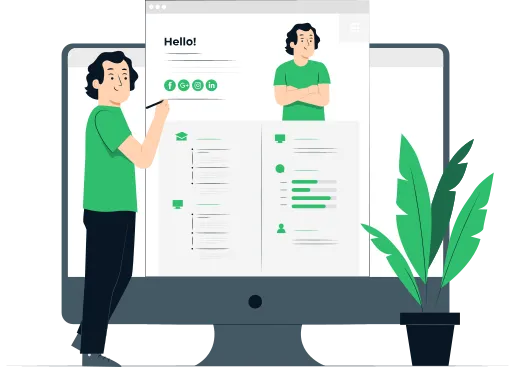
Build your Resume in 15 minutes
Create an awesome resume that meets the expectations of potential employers with our selection of professional, field-tested resume templates.

